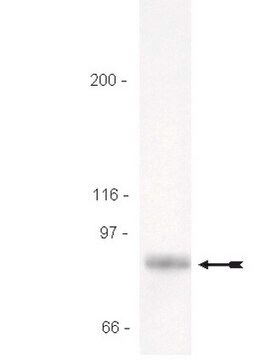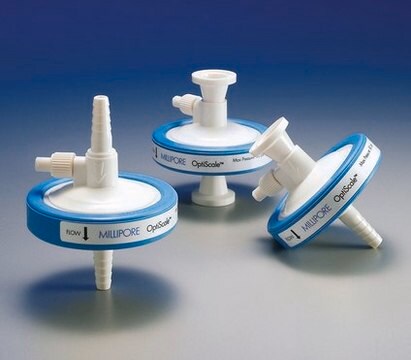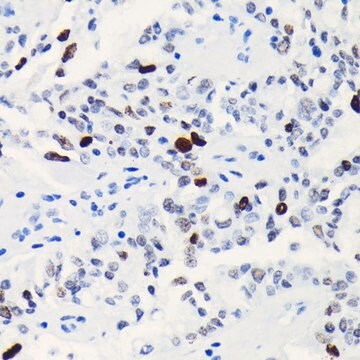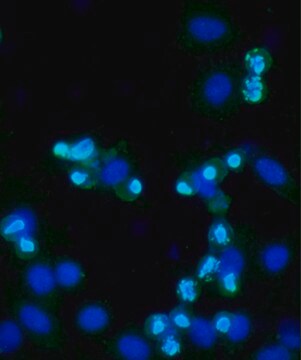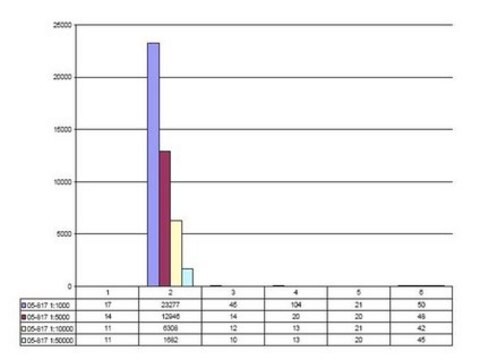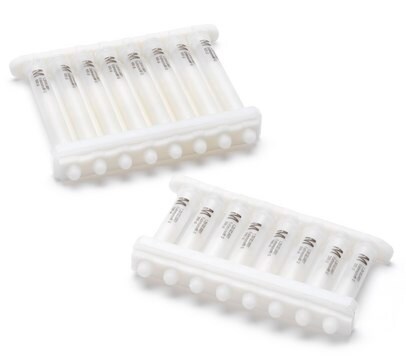17-10269
ChIPAb+ Phospho-Histone H3 (Ser28) Antibody
from rabbit, purified by affinity chromatography
Sinonimo/i:
Histone H3.1t, H3/t, H3t, H3/g
About This Item
Prodotti consigliati
Origine biologica
rabbit
Livello qualitativo
Forma dell’anticorpo
affinity purified immunoglobulin
Clone
polyclonal
Purificato mediante
affinity chromatography
Reattività contro le specie
mouse, human
Produttore/marchio commerciale
ChIPAb+
Upstate®
tecniche
ChIP: suitable
dot blot: suitable
immunocytochemistry: suitable
inhibition assay: suitable (peptide)
western blot: suitable
N° accesso NCBI
N° accesso UniProt
Condizioni di spedizione
dry ice
Descrizione generale
The ChIPAb+ Phospho-Histone H3 (Ser28) set includes the Phospho-Histone H3 (Ser28) antibody, a Normal Rabbit IgG, and control primers which amplify a 166 bp region of the human GAPDH promoter. The Phospho-Histone H3 (Ser28) and negative controls are supplied in a scalable "per ChIP" reaction size and can be used to functionally validate the precipitation of Phospho-Histone H3 (Ser28)-associated chromatin.
Immunogeno
Applicazioni
Representative lot data.
Sonicated chromatin prepared from untreated or colcemid-treated HeLa cells (1 X 106 cell equivalents per IP) were subjected to chromatin immunoprecipitation using either 5 µl Normal rabbit IgG, or 5 µl Anti-phospho-Histone H3 (Ser28) and the Magna ChIP® A Kit (Cat. # 17-610). Successful immunoprecipitation of phospho-Histone H3 (Ser28)- associated DNA fragments was verified by qPCR using ChIP Primers, human GAPDH promoter region for untreated and treated chromatin samples (Figure 2). Data is presented as percent input of each IP sample relative to input chromatin for each amplicon and ChIP sample as indicated.
Please refer to the EZ-Magna ChIP A (Cat. # 17-408) or EZ-ChIP (Cat. # 17-371) protocol for experimental details.
Western Blot Analysis:
Representative lot data.
HeLa acid extract (lane 1) and recombinant Histone H3 (lane 2) were probed with Anti-phospho-Histone H3 (Ser28) (1:2,000 dilution).
Proteins were visualized using a Donkey Anti-Rabbit IgG secondary antibody conjugated to HRP and a chemiluminescence detection system. (Figure 3)
Arrow indicates phospho-Histone H3 (Ser28) (~17 kDa).
Dot Blot Specificity Analysis:
Representative lot data.
Histone peptides with various modifications (see table) were probed with Anti-phospho-Histone H3 (Ser28). Proteins were visualized using a Donkey Anti-Rabbit IgG secondary antibody conjugated to HRP and a chemiluminescence detection system. (Figure 4)
Immunocytochemistry Analysis
Representative lot data
Confocal fluorescent analysis of HeLa cells using Anti-phospho-Histone H3 (Ser28) (Red). Actin filaments have been labeled with AlexaFluor 488 dye-Phalloidin (Green). Nucleus is stained with DAPI (Blue). This antibody positively stains the mitotic cell nucleus. (Figure 5)
Peptide Inhibition Assay: A 1:500 dilution from a representative lot was blocked by phospho-Histone H3 (Ser28) peptides, but not non-specific peptides.
Epigenetics & Nuclear Function
Histones
Confezionamento
Qualità
Representative lot data.
Sonicated chromatin prepared from colcemid-treated HeLa cells (1 X 106 cell equivalents per IP) were subjected to chromatin immunoprecipitation using either 5 µl Normal rabbit IgG, or 5 µl Anti-phospho-Histone H3 (Ser28) and the Magna ChIP® A Kit (Cat. # 17-610). Successful immunoprecipitation of phospho-Histone H3 (Ser28)-associated DNA fragments was verified by qPCR using ChIP Primers, human GAPDH promoter region (Figure 1).
Please refer to the EZ-Magna ChIP A (Cat. # 17-408) or EZ-ChIP (Cat. # 17-371) protocol for experimental details.
Descrizione del bersaglio
Stato fisico
Normal Rabbit IgG. Two vials containing 75 μL of normal rabbit IgG in buffer containing 0.01M PBS with 0.1% sodium azide. Store at -20°C.
ChIP Primers, human GAPDH promoter. One vial containing 75 μL of 5 μM each primer specific for human GAPDH. Store at -20°C.
FOR: TAC TAG CGG TTT TAC GGG CG
REV: TCG AAC AGG AGG AGC AGA GAG CGA
Stoccaggio e stabilità
Note: Variability in freezer temperatures below -20°C may cause glycerol containing solutions to become frozen during storage.
Risultati analitici
Includes normal rabbit IgG and primers specific for human GAPDH promoter
Note legali
Esclusione di responsabilità
Codice della classe di stoccaggio
10 - Combustible liquids
Certificati d'analisi (COA)
Cerca il Certificati d'analisi (COA) digitando il numero di lotto/batch corrispondente. I numeri di lotto o di batch sono stampati sull'etichetta dei prodotti dopo la parola ‘Lotto’ o ‘Batch’.
Possiedi già questo prodotto?
I documenti relativi ai prodotti acquistati recentemente sono disponibili nell’Archivio dei documenti.
Il team dei nostri ricercatori vanta grande esperienza in tutte le aree della ricerca quali Life Science, scienza dei materiali, sintesi chimica, cromatografia, discipline analitiche, ecc..
Contatta l'Assistenza Tecnica.


